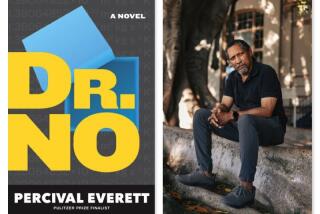Lydia Millet really goes to extremes
TUCSON -- What you can typically count on, opening one of the witty and uncomfortable novels by former Angeleno Lydia Millet, are characters who run the gamut from the unlikable to the despicable to the unknowable. And that’s not just the minor characters: These ciphers and psychopaths are often the people who will accompany us on a 300- or 400-page ride.
“I’ve always been interested in obsessive, insane people,” she said over dinner at a manicured desert lodge not far from the environmental organization Center for Biological Diversity, where she works as writer and editor.
These characters are not just lovably eccentric. In Millet’s latest, “How the Dead Dream,” which Counterpoint published this month, we experience the story through a remote, isolated real estate developer named T., who begins the novel falling in love with the images on American currency.
His father is an irresponsible narcissist and his de facto best friend a frat-boy capitalist who picks a fight with a handicapped girl, and whom the Washington Post, in an otherwise positive review, described as marked by “cartoon-like crassness.”
Over the years, Millet’s protagonists have included, in the book “My Happy Life,” an abused woman abandoned in a mental institution and a drunken pornographer who thinks he’s the messiah. The latter appeared in a book called “Everyone’s Pretty” that one of Millet’s best college friends, her then-editor at Algonquin Books, told her was reprehensible -- right before she rejected the book itself.
Millet, now 39, survived the blow: Though she lives a low-key life in a desert retreat with her family, which includes a newborn boy, and works a day job, she’s one of the most acclaimed novelists of her generation. Critics have compared her favorably to Kurt Vonnegut and Haruki Murakami. Jonathan Lethem has called her one of his favorite writers.
The book’s protagonist takes a radical, if at times puzzling, personal journey, which reflects the author’s interest in wildlife and nature. But the other characters don’t exactly change for the better. How unlikely are these people?
“It may look extreme on the page,” said Millet, who in person is warmer and more down to earth than her dry-ice literary voice might lead you to assume, “but they’re not really that extreme. I’ve known a lot of them. I do like obsessive people. There’s a lot of moderation in literary fiction right now, and I’m not interested in being a part of that.”
L.A. as metaphor
The author’s attraction to intense or exaggerated characters dates back to her years in Los Angeles, where she continues to set her novels.
“Most of my books have something to do with L.A.,” she said. “L.A. for me is a perfect microcosm of America. Because it’s so profligate, and so glamorous, and so anti-intellectual, finally.” New York “is, by comparison, European. And because I want to write about the extremes of Americanism, I find myself most appropriately located in Los Angeles. I never seem to leave L.A., though I left L.A.”
Millet -- who grew up in Toronto, the daughter of an Egyptologist father and librarian mother -- moved to L.A. after dropping out of an MFA program at the University of Arizona after a single semester. L.A. seemed like a comfortable place where she could slip easily into writing screenplays.
Those years were certainly filled with extremes: Soon after landing in town, in 1991, and taking increasingly unpleasant jobs in Hollywood, she went to work for Larry Flynt, copy editing such august publications as Fighting Knives, S.W.A.T.: Special Weapons and Tactics for the Prepared American, Hustler’s Busty Beauties and what she calls “the particularly vile Barely Legal.”
Along the way came the L.A. riots, the Northridge earthquake, several waves of fires, her near-mugging in Venice (which she calls “the stupidest moment of my life”) and the theft of her car.
Though her writing degree was in flames and her screenplay career going nowhere, she learned a lot about writing and human nature from her often eccentric co-workers and the prisoners at San Quentin and elsewhere, whose letters and often oddball anatomical gifts she looked forward to receiving. Hustler became her MFA.
“Everybody at that place wanted to be something else,” said Randolph Heard, an L.A. television writer who met Millet while the two worked at Flynt and later lived with her for seven years and remains a close friend. “But never have I met with someone so doggedly in pursuit. In the weeks she wasn’t writing she was a miserable person. It was clear to me who she would become.”
Despite an almost sparkling intelligence and a very polished, often poetic writing style, Millet’s work can be dark, even disorienting, lacking some of the comfortable pleasures of identification, uplifting plot turns or clean resolution.
One critic, Claude Crowley in the Fort Worth Star-Telegram, described 2002’s “My Happy Life” as “too violent, cryptic and intense to appeal to any but a limited readership of literati with unorthodox taste.” He may well be right, but the novel went on to win the PEN USA Literary Award for fiction.
A dedicated publisher
It was “Everyone’s Pretty,” a few years later, that drew the attention of publisher Richard Nash, who has since edited and published her at both Soft Skull Press and Counterpoint. “I bloody loved that book,” Nash said. “I thought it was the most hilarious, wise, wild thing I’ve ever read.”
Nash liked her work so much, he said, that he risked the financial stability of his press, maxing out its limited promotional budget, each time he published her. “Lydia is able to see through the world in a certain kind of way, to see through certain hypocrisies, to see patterns and structures and to reveal them to the reader in prose of sharpness and clarity.”
She’s in the tradition of Waugh, he said, but with social consciousness.
Her books also tend to break conventions, whether the convention to have a likable, psychologically whole character who becomes a reader surrogate, or the convention of narrative realism. Her breakthrough book, 2005’s “Oh Pure and Radiant Heart,” reincarnated three of the architects of the atomic bomb -- Robert J. Oppenheimer, Enrico Fermi and Leo Szilard -- in contemporary New Mexico.
Domestic realism, and documenting social customs and relationships, holds little interest for Millet. She’s bored by the main line of American literary fiction, “where everything is contained within the personal and all stories are about individuals with personal problems. I don’t think fabulist writing is any less ‘real’ than what we call realism. I just don’t think it allows for much political or philosophical discourse.”
She sees greater freedom of character and storytelling in art, music, advertising and film. “Nothing is verboten in Hollywood movies,” she said, “when you come right down to it. Vicious characters in mainstream movies -- people love them, they eat it up! There’s nothing wrong with caricature or cartoon: It’s everywhere. And yet we try to limit the novel to conventional, multidimensional characters we have to be able to relate to at every turn. We have to be able to put our feet ‘in the shoes’ of our protagonists.”
Among American writers, she said, she doesn’t see many forebears, preferring European writers like Italo Calvino, Thomas Bernhard and Milan Kundera -- who work with politics, ideas and distorted characters in expansive language -- or abstract, experimental writers like Samuel Beckett.
“I get angry when I read Beckett,” she said. “I become full of rage at the obscurity of some of the language. But I love it, and I love the feelings of rage that it provokes. I actually think the complex emotions you feel trying to read Beckett are valuable in themselves, and they’re not all positive. It makes you step outside yourself in an interesting way.”
More to Read
Sign up for our Book Club newsletter
Get the latest news, events and more from the Los Angeles Times Book Club, and help us get L.A. reading and talking.
You may occasionally receive promotional content from the Los Angeles Times.






